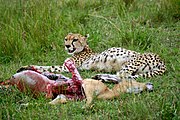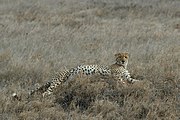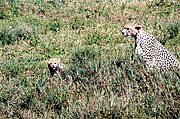| Cheetah[1] Fossil range: Late Pliocene to Recent | ||||||||||||||||
|---|---|---|---|---|---|---|---|---|---|---|---|---|---|---|---|---|
 | ||||||||||||||||
| Conservation status | ||||||||||||||||
Vulnerable (IUCN 3.1)[2] | ||||||||||||||||
| Scientific classification | ||||||||||||||||
| ||||||||||||||||
| Binomial name | ||||||||||||||||
| Acinonyx jubatus (Schreber, 1775) | ||||||||||||||||
| Type species | ||||||||||||||||
| Acinonyx venator Brookes, 1828 (= Felis jubata,Schreber, 1775) by monotypy | ||||||||||||||||
 The range of the cheetah | ||||||||||||||||
| Subspecies | ||||||||||||||||
A. j. hecki |
The cheetah (Acinonyx jubatus) is an atypical member of the cat family (Felidae) that is unique in its speed, while lacking climbing abilities. As such, it is placed in its own genus, Acinonyx. It is the fastest land animal, reaching speeds between 112 and 123 km/h (70 and 76 mph)[3] in short bursts covering distances up to 460 m (1,500 ft), and has the ability to accelerate from 0 to 110 km/h (68 mph) in three seconds, greater than most supercars.[4].
The word "cheetah" is derived from the Sanskrit word chitrakāyaḥ, meaning "variegated body", via the Hindiचीता cītā.[5]
Contents[hide]
|
[edit]Description
The cheetah's chest is deep and its waist is narrow. The coarse, short fur of the cheetah is tan with round black spots measuring from 2 to 3 cm (0.79 to 1.2 in) across, affording it some camouflage while hunting. There are no spots on its white underside, but the tail has spots, which merge to form four to six dark rings at the end. The tail usually ends in a bushy white tuft. The cheetah has a small head with high-set eyes. Black "tear marks" run from the corner of its eyes down the sides of the nose to its mouth to keep sunlight out of its eyes and to aid in hunting and seeing long distances.
The adult cheetah weighs from 40 to 65 kg (88 to 140 lb). Its total body length is from 115 to 135 cm (45 to 53 in), while the tail can measure up to 84 cm (33 in) in length. Males tend to be slightly larger than females and have slightly bigger heads, but there is not a great variation in cheetah sizes and it is difficult to tell males and females apart by appearance alone. Compared to a similarly-sized leopard, the cheetah is generally shorter-bodied, but is longer tailed and taller (it averages about 90 cm (35 in) tall) and so it appears more streamlined.
Some cheetahs also have a rare fur pattern mutation: cheetahs with larger, blotchy, merged spots are known as 'king cheetahs'. It was once thought to be a separate subspecies, but it is merely a mutation of the African cheetah. The 'king cheetah' has only been seen in the wild a handful of times, but it has been bred in captivity.
The cheetah's paws have semi-retractable claws[6] (known only in three other cat species - the Fishing Cat, the Flat-headed Cat and theIriomote Cat) offering the cat extra grip in its high-speed pursuits. The ligament structure of the cheetah's claws is the same as those of other cats; it simply lacks the sheath of skin and fur present in other varieties, and therefore the claws are always visible, with the exception of thedewclaw. The dewclaw itself is much shorter and straighter than other cats.
Adaptations that enable the cheetah to run as fast as it does include large nostrils that allow for increased oxygen intake, and an enlarged heart and lungs that work together to circulate oxygen efficiently. During a typical chase its respiratory rate increases from 60 to 150 breaths per minute.[6] While running, in addition to having good traction due to its semi-retractable claws, the cheetah uses its tail as a rudder-like means of steering to allow it to make sharp turns, necessary to outflank prey who often make such turns to escape.
Unlike "true" big cats, the cheetah can purr as it inhales, but cannot roar. By contrast, the big cats can roar but cannot purr, except while exhaling. However, the cheetah is still considered by some to be the smallest of the big cats. While it is often mistaken for the leopard, the cheetah does have distinguishing features, such as the aforementioned long "tear-streak" lines that run from the corners of its eyes to its mouth. The body frame of the cheetah is also very different from that of the leopard, most notably so in its thinner and longer tail, and unlike the leopard, its spots are not arranged into rosettes.
The cheetah is a vulnerable species. Out of all the big cats, it is the least able to adapt to new environments. It has always proved difficult to breed in captivity, although recently a few zoos have managed to succeed at this. Once widely hunted for its fur, the cheetah now suffers more from the loss of both habitat and prey.
The cheetah was formerly considered to be particularly primitive among the cats and to have evolved approximately 18 million years ago. New research, however, suggests that the last common ancestor of all 40 existing species of felines lived more recently than that - about 11 million years ago. The same research indicates that the cheetah, while highly derived morphologically, is not of particularly ancient lineage, having separated from its closest living relatives (Puma concolor, the cougar, and Puma yaguarondi, the jaguarundi) around five million years ago.[7][8]. These felids haven't changed much since they first appeared in the fossil record.
[edit]Reproduction and social life
Females reach maturity within twenty to twenty-four months, and males around twelve months (although they do not usually mate until at least three years old), and mating occurs throughout the year. A study of cheetahs in the Serengeti showed that females are sexually promiscuous and often have cubs by many different males.[9]
Females give birth to up to nine cubs after a gestation period of ninety to ninety-eight days, although the average litter size is three to five. Cubs weigh from 150 to 300 g (5.3 to 11 oz) at birth. Unlike some other cats, the cheetah is born with its characteristic spots. Cubs are also born with a downy underlying fur on their necks, called a mantle, extending to mid-back. This gives them a mane or Mohawk-type appearance; this fur is shed as the cheetah grows older. It has been speculated that this mane gives a cheetah cub the appearance of the Honey Badger (Ratel), to scare away potential aggressors.[10] Cubs leave their mother between thirteen and twenty months after birth. Life span is up to twelve years in the wild, but up to twenty years in captivity.
Unlike males, females are solitary and tend to avoid each other, though some mother/daughter pairs have been known to be formed for small periods of time. The cheetah has a unique, well-structured social order. Females live alone except when they are raising cubs and they raise their cubs on their own. The first eighteen months of a cub's life are important - cubs learn many lessons because survival depends on knowing how to hunt wild prey species and avoid other predators. At eighteen months, the mother leaves the cubs, who then form a sibling, or "sib" group, that will stay together for another six months. At about two years, the female siblings leave the group, and the young males remain together for life.
[edit]Territories
[edit]Males
Males are very sociable and will group together for life, usually with their brothers in the same litter; although if a cub is the only male in the litter then two or three lone males may group up, or a lone male may join an existing group. These groups are called coalitions. A coalition is six times more likely to obtain an animal territory than a lone male, although studies have shown that coalitions keep their territories just as long as lone males — between four and four and a half years.
Males are very territorial. Females' home ranges can be very large and trying to build a territory around several females' ranges is impossible to defend. Instead, males choose the points at which several of the females' home ranges overlap, creating a much smaller space, which can be properly defended against intruders while maximizing the chance of reproduction. Coalitions will try their most to maintain territories in order to find females with whom they will mate. The size of the territory also depends on the available resources; depending on the part of Africa, the size of a male's territory can vary greatly from 37 to 160 km2 (14 to 62 sq mi).
Males mark their territory by urinating on objects that stand out, such as trees, logs, or termite mounds. The whole coalition contributes to the scent. Males will attempt to kill any intruders and fights result in serious injury or death.
[edit]Females
Unlike males and other felines, females do not establish territories. Instead, the area they live in is termed ahome range. These overlap with other females' home ranges, often those of their daughters, mothers, or female littermates. Females always hunt alone, although cubs will accompany their mothers to learn to hunt once they reach the age of five to six weeks.
The size of a home range depends entirely on the availability of prey. Cheetahs in southern Africanwoodlands have ranges as small as 34 km2 (13 sq mi), while in some parts of Namibia they can reach 1,500 km2 (580 sq mi).
[edit]Vocalizations
The cheetah cannot roar, unlike other big cats, but does have the following vocalizations:
- Chirping - When cheetahs attempt to find each other, or a mother tries to locate her cubs, it uses a high-pitched barking called chirping. The chirps made by a cheetah cub sound more like a bird chirping, and so are termed chirping.
- Churring or stuttering - This vocalization is emitted by a cheetah during social meetings. A churr can be seen as a social invitation to other cheetahs, an expression of interest, uncertainty, or appeasement or during meetings with the opposite sex (although each sex churrs for different reasons).
- Growling - This vocalization is often accompanied by hissing and spitting and is exhibited by the cheetah during annoyance, or when faced with danger.
- Yowling - This is an escalated version of growling, usually displayed when danger worsens.
- Purring - This is made when the cheetah is content, usually during pleasant social meetings (mostly between cubs and their mothers).
[edit]Interspecific predatory relationships
Cheetahs are outranked by all the other large predators in most of their range. Because they are designed for extreme bursts of short speed at the expense of both power and the ability to climb trees, they cannot defend themselves against most of Africa's other predator species. They avoid fighting typically and will surrender a kill immediately to even a single hyena, rather than risk any injury, as anything that slows them down is essentially life threatening. The cheetah's death rate is very high during the early weeks of its life; up to 90% of cheetah cubs are killed during this time by lions, leopards, hyenas wild dogs, or even by eagles. Cheetah cubs often hide in thick brush for safety. Mother cheetahs will defend their young and are at times successful in driving predators away from their cubs. Coalitions of male cheetahs can also chase away other predators, depending on the coalition size and the size and number of the predator. Because of its speed, a healthy adult cheetah has no predators. [11]
A cheetah has a 50% chance of losing its kills to other predators.[6] Cheetahs avoid competition by hunting at different times of the day and by eating immediately after the kill. Due to the reduction in habitat in Africa, Cheetahs in recent years have faced greater pressure from other native African predators as available range declines.
[edit]Diet and hunting
The cheetah is a carnivore, eating mostly mammals under 40 kg (88 lb), including the Thomson's Gazelle, the Grant's gazelle, the springbok and the impala. The young of larger mammals such as wildebeests andzebras are taken at times, and adults too, when the cats hunt in groups. Guineafowl and hares are also prey. While the other big cats mainly hunt by night, the cheetah is a diurnal hunter. It hunts usually either early in the morning or later in the evening when it is not so hot, but there is still enough light.
The cheetah hunts by vision rather than by scent. Prey is stalked to within 10–30 m (33–98 ft), then chased. This is usually over in less than a minute, and if the cheetah fails to make a catch quickly, it will give up. The cheetah has an average hunting success rate of around 50% - half of its chases result in failure.[6]
Running at speeds up to 112 km/h (70 mph) puts a great deal of strain on the cheetah's body. When sprinting, the cheetah's body temperature becomes so high that it would be deadly to continue - this is why the cheetah is often seen resting after it has caught its prey. If it is a hard chase, it sometimes needs to rest for half an hour or more. The cheetah kills its prey by tripping it during the chase, then biting it on the underside of the throat to suffocate it, for the cheetah is not strong enough to break the necks of the four-legged prey it mainly hunts. The bite may also puncture a vital artery in the neck. Then the cheetah proceeds to devour its catch as quickly as possible before the kill is taken by stronger predators.
The diet of a cheetah is dependent upon the area in which it lives. For example, on the East African plains, its preferred prey is the Thomson's Gazelle. This small antelope is shorter than the cheetah (about 58–70 cm (23–28 in) tall and 70–107 cm (28–42 in) long), and also cannot run faster than the cheetah (only up to 80 km/h (50 mph)), which combine to make it an appropriate prey. Cheetahs look for individuals which have strayed some distance from their group, and do not necessarily seek out old or weak ones.
[edit]Habitat
The cheetah thrives in areas with vast expanses of land where prey is abundant. The cheetah prefers to live in an open biotope, such as semi-desert, prairie, and thick brush, though it can be found in a variety of habitats. In Namibia, for example, it lives in grasslands, savannahs, areas of dense vegetation, and mountainous terrain.
The cheetah is found in the wild primarily in Africa, but in the past its range extended into much of Asia, and a small population survives in Iran, where conservationists are taking steps to protect it. In much of its former range, it was tamed by aristocrats and used to hunt antelopes in much the same way as is still done with members of the greyhound group of dogs. Aside from an estimated fifty cheetahs living in the Khorasan Province of Iran,[12] the distribution of the cheetah is now limited to Africa.
Of the five subspecies of cheetah in the genus Acinonyx, four live in Africa and one in Iran. It is possible, though doubtful, that some cheetahs remain in India. There have also been several unconfirmed reports of Asiatic Cheetahs in the Balochistan province of Pakistan, with at least one dead animal being recovered recently.[13]
[edit]Genetics and classification
The genus name, Acinonyx, means "no-move-claw" in Greek, while the species name, jubatus, means "maned" in Latin, a reference to the mane found in cheetah cubs.
The cheetah has unusually low genetic variability and a very low sperm count, which also suffers from lowmotility and deformed flagellae[6]. Skin grafts between non-related cheetahs illustrate this point in that there is no rejection of the donor skin. It is thought that it went through a prolonged period of inbreeding following a genetic bottleneck during the last ice age. It probably evolved in Africa during the Miocene epoch (26 million to 7.5 million years ago), before migrating to Asia. New research by a team led by Warren Johnson and Stephen O'Brien of the Laboratory of Genomic Diversity (National Cancer Institute in Fre






